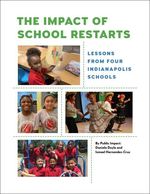Districts are increasingly joining with external providers—often charter operators—to implement “restarts” as one way to turn around persistently struggling schools. In a restart, a school continues to serve the same community, while its new provider receives operational autonomy in exchange for a contractual commitment to raise student outcomes. Our ongoing research has documented more than 200 such restarts in 16 states between 2010–11 and 2016–17, as leaders seek alternatives to closing struggling schools or allowing them to languish.
With restarts gaining traction, the field needs much better information and insight about the approach. How well are restarted schools performing? What challenges have arisen? And what can leaders do to increase restart success? In The Impact of School Restarts: Lessons from Four Indianapolis Schools, Public Impact’s Daniela Doyle and Ismael Hernandez-Cruz take a deep dive into the data from four restarts that started within Indianapolis Public Schools (IPS) between the 2015–16 and 2017–18 school years, as well as interviews with school and district staff. As researchers have documented elsewhere, the authors found mixed results in Indianapolis.
- Student enrollment increased at all four restarts, and reenrollment rates increased at three.
- The longest-running of the restarts, Phalen Leadership Academy @ 103, made double-digit student learning growth in both ELA (English language arts) and math during the study period.
- Other schools made gains in one subject but not the other, or showed less growth than in the three years prior to the restart.
- At least two years of restart data were available for three of the schools. In the two years following the restart, students who remained in the restarted school made bigger gains than those who went elsewhere in one of three schools in ELA, and in two of three schools in math.
Given the small number of restarts and tested students included in the study, the findings from this analysis are not conclusive. The field needs more research on a larger and more diverse set of schools to more confidently identify what works, what doesn’t, and why.
The experiences of these four schools, however, point toward three lessons for districts, states, and educators to consider when restarting a school:
- The restart opportunity can attract high-potential school operators. IPS’s experience demonstrates that access to district resources, especially facilities and local tax dollars, can induce promising operators to take on the challenging work of reviving long-struggling schools.
- Early and honest community engagement can smooth the process. Though less disruptive than closure, restart is a major change for students, families, and the community. IPS leaders and operators learned, sometimes the hard way, the importance of putting deep thought and energy into authentic community engagement from the beginning to help clear the path for restarts.
- More seamless data systems are needed to support systems of schools across a city. As more operators share responsibility for enrolling students in a city, leaders need improved data infrastructures that make it possible to follow students as they change schools and track their learning throughout their schooling. Better data will enable education leaders and policymakers to make better decisions about restarts in the future.
The Indianapolis research builds on Public Impact’s prior work on school restarts, which includes additional studies as well as practical tools for leaders implementing the approach. Additional resources are available here.

